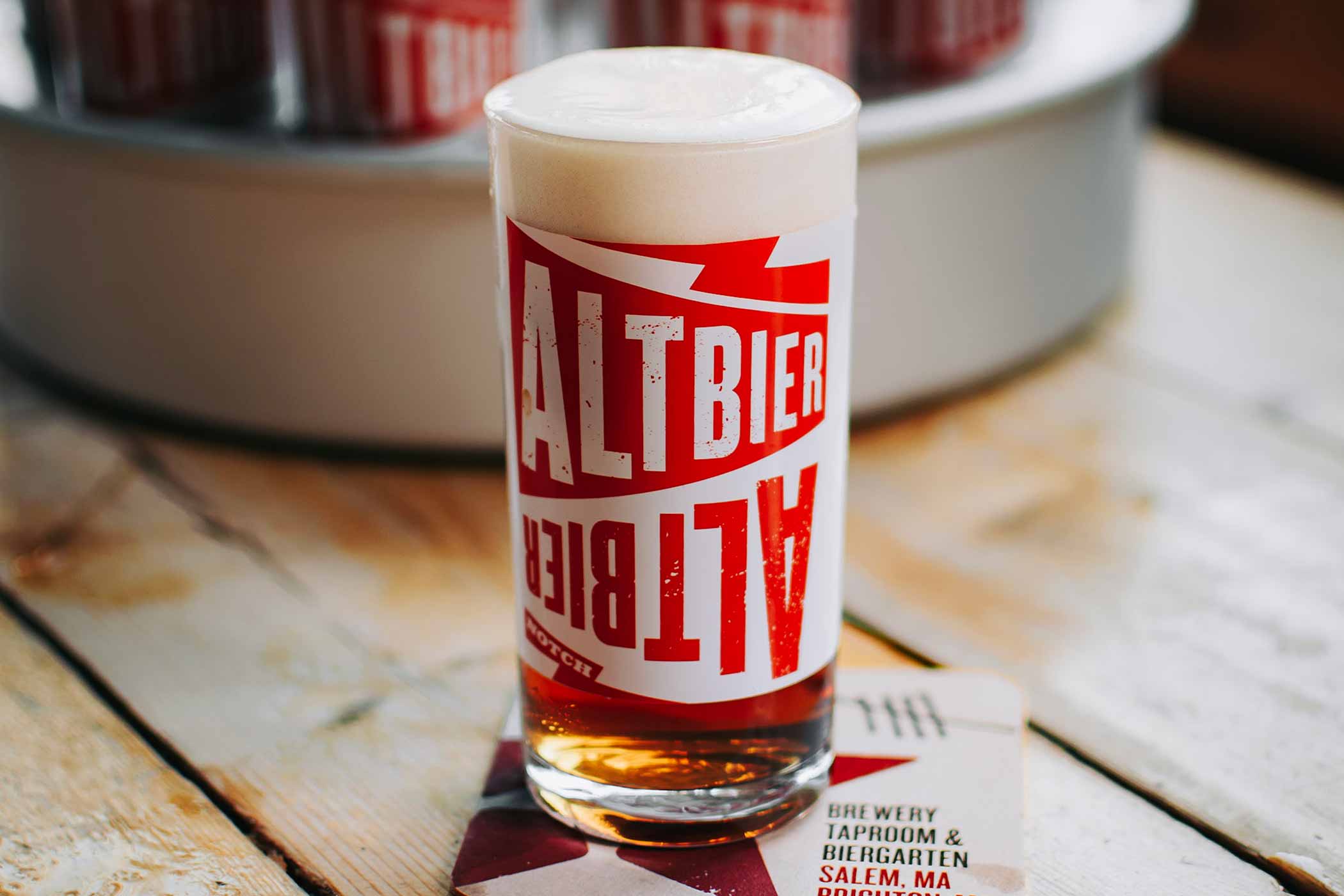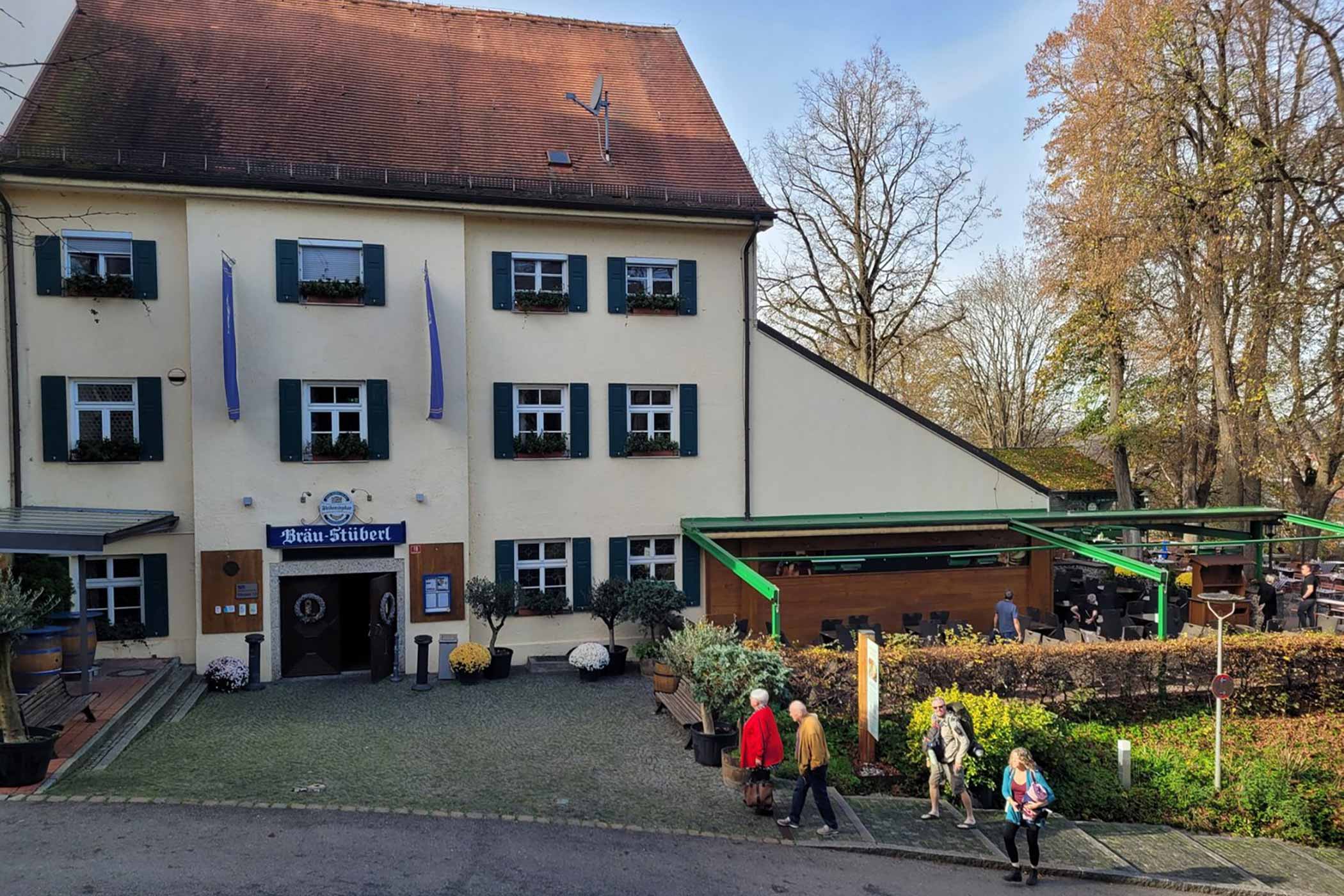Shop
What Exactly Is an Altbier? We Asked the Experts
Looking for More?
Let’s ask that question again: What is altbier?
According to Hausbrauerie Zum Schlüssel Braumeister Dirk Rouenhoff, who was born in the Lower Rhine Region and grew up drinking this style, “Altbier is a brown, top-fermented beer with BU between twenty-five and forty; it is a local specialty with a wide range of different characters.”
Wayfinder Beer Brewmaster Natalie Rose Baldwin also goes to color, but a different one, specifically “the whole area of amber ale or amber lager,” she says.
Notch Brewing Founder Chris Lohring splits the middle here, calling Altbier a “copper, amber, brown, however you want to describe it,” he says.
“It’s a confusing style to think about because you see color, and you expect a certain intensity of flavor,” says Tamir Danon, co-founder of Novel Strand Brewing in Denver, CO. “But that’s where I think an Altbier will f**k with you.”
I know this firsthand, having tried Novel Strand’s Alt School Like That when I visited two years ago. “It screwed with your head when you had it at the brewery,” Danon reminds me. “But that’s why you still think about it.”
And I do, obviously, because I called Danon to chat about this piece.
I couldn’t quite put my finger on what stuck out to me about Altbier because it’s not a flashy style. There is no one thing sticking out. You get a maltiness, but not overly so. You get a bitterness, but not overly so. I just couldn’t quite figure out why I enjoyed this beer so much, and yet I kept going back for more.
Danon and I once again spent over an hour dissecting it and still couldn’t find an answer.
“It’s a style that technically has no flair, pizzazz, or anything technically exciting. The malt isn’t particularly super sexy or has a crazy story; it’s just Weyermann malt. The hops are just Hallertau Tradition. The yeast is the yeast. It’s not a hot, sexy beer,” he exclaimed. “But when someone tries that beer, they’re very likely to have it again.”
So to recap: Altbier is a sometimes brown, sometimes red, occasionally amber ale that has a sweetness, but not too sweet, a maltiness that’s not over the top, and a dryness that drinks like a lager (but is it a lager? Or is it an ale?) and has a present bitterness.
While the style may f**k with you, vary, and change depending on who makes it, one thing that absolutely everyone I interviewed for this piece could agree on?
Altbier is from Düsseldorf, Germany. And that is one of its defining characteristics.
Dusseldorf: The Home of Altbier

Photography courtesy of Hausbrauerei Zum Schlüssel
Altbier is to Düsseldorf as kölsch is to Cologne. In fact, the cities are about forty kilometers (twenty-five miles) apart, a quick train ride.
Rouenhoff says the style gets its name from its old and traditional way of production before refrigeration. “In our region, we had no ice cellars or anything else to store some ice for the beer production in the summer,” he explains. “So they produced a beer with a warm and top-fermenting yeast, which needed no cooling during the [brewing] process.”
Much like brewers in California created steam beer because of a lack of consistent ice, brewers in Düsseldorf came up with their own solution for brewing in their conditions.
Breakside Brewery’s Brewmaster Ben Edmunds, who has been brewing an Altbier since 2012, cannot think of the beer style without this Western German town, which he visited for the first time while attending brewing school in Germany.
“It’s one of only a handful of styles that we associate so intimately with one place,” he says.
Lohring agrees. When I asked him to describe Altbier, he replied, “I think [Altbier] is a place more than anything.” Lohring visited Dusseldorf for the first time in 2017 after brewing an Altbier at Notch. “Düsseldorf comes right to mind in terms of the city’s affinity for that style and the culture around it,” he shares.
Lohring wanted to better understand where this beer came from, how it tasted, and the culture around it. He found Düsseldorf an extraordinary place full of warm breweries and beer halls plush with Altbier.
But it turns out we might have such a hard time defining Altbier ourselves because you can’t find any unified version, even in the style’s birthplace.
“It quickly became apparent that this style is about as narrow as saison,” Hop Culture Freelancer Ryan Pachmayer shared. Pachmayer, who has written excellent guides for us to Munich and Franconia, has also spent time in Düsseldorf. “[Altbier] is all over the place. Some things tasted like English brown ales; some tasted like Baltic porters, some like a mild, some even sort of like American hoppy reds,” he told me. “It was wild!”
The widely varying versions shocked Pachmayer. “To the extent that I’d have a difficult time calling an American version not-authentic,” he wrote in some trip notes that he shared with me. “It really ran the gamut, from light and malty to malty with good hop balance, to weirdly spritzy with dominant yeast flavor to super hoppy, to light and dry, to porter-like, to rustic English brown. It was perhaps the biggest surprise of the trip to me.”
Edmunds had a similar experience: “I was surprised going to Düsseldorf for the first time just how diverse and wide the style ran,” he says.
Lohring likens it to Czech pilsner or really more Czech pale lager in the Czech Republic. “You can’t walk away from the Czech Republic saying Czech Pilsner or pale lager is ‘X’ because there are too many examples, and a lot don’t taste like each other,” he notes, sharing that we tend to want to define styles too narrowly where we should instead think of it more as a category that has some pretty wide-ranging attributes. I’d say Düsseldorf Altbier fits that pretty firmly.”
Even for those who had been to Düsseldorf, their favorite version varied.
Lohring likes the Uerige Alt, which is a pretty popular choice. “It just struck a really nice balance with nothing sticking out too much,” he says, noting that for a brewer, that’s very hard to achieve. “Also, it was the most drinkable.”
During his trip, Lohring recalls drinking this Altbier the most. “I usually think the ones we go back to and drink the most are the ones we like most,” he laughs.
Edmunds found Uerige’s Altbier quite a bit drier and lighter-bodied than what he was used to from American craft breweries. “To this day, American brewers generally lean toward the richer, really heavily, overly malty expressive versions of the style,” he notes, saying that isn’t necessarily bad. However, at Breakside, he tries to emulate the lighter, leaner, less chewy versions he had in Düsseldorf.
Although, it could account for further confusion around the style. Similar to how Americans perceive “Oktoberfest” as a style to be an amber, maltier Märzen rather than a paler, hoppier Festbier. (Wondering what we’re talking about? We’ve got an excellent primer for you here!)
“I think too many American ones are insanely hoppy or overly sweet,” shares Pachmayer, who finds Uerige’s version more of a hoppy red ale or American version of ESB circa 2010.
Even among the experts, personal preferences differ, and they agree that the nature of this style remains elusive.
The ABCs: Altbier Beer Characteristics
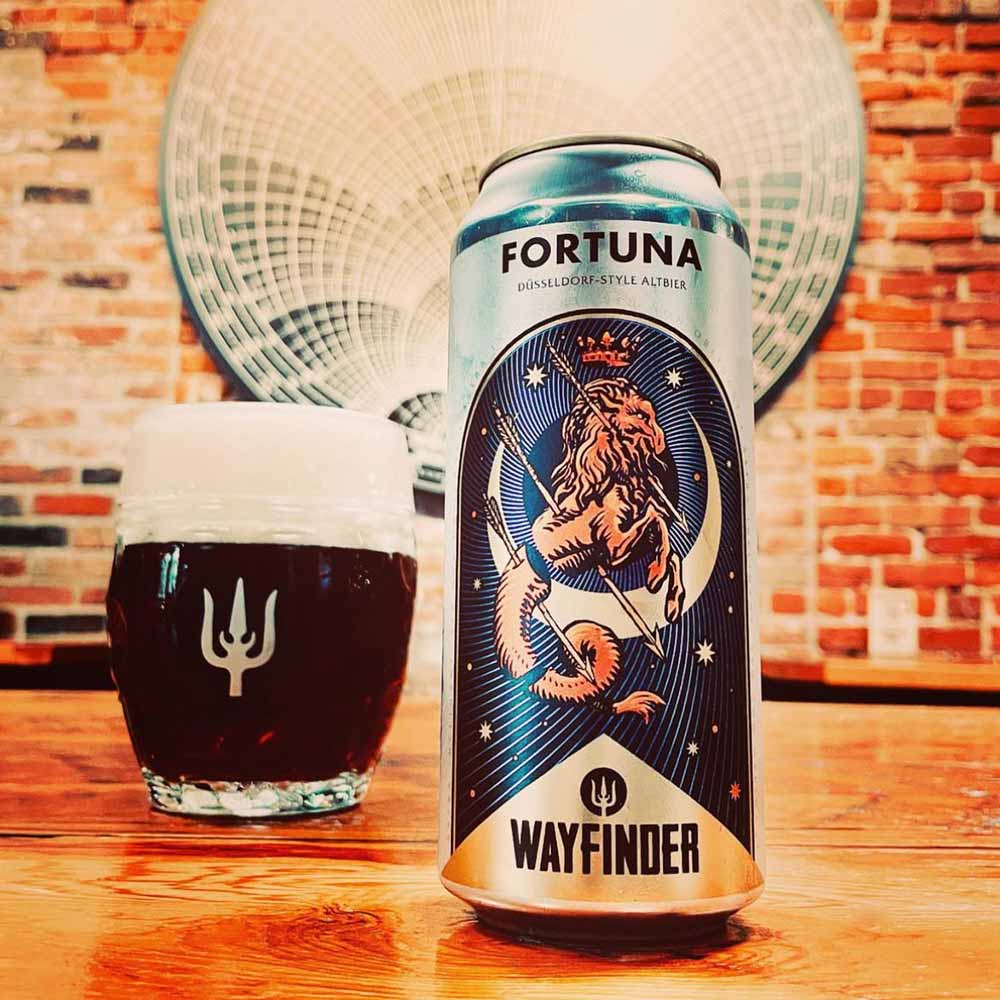
Photography courtesy of Orion Landau | Wayfinder Beer
For what it’s worth, let’s try to capture lightning in an Altbier bottle. While lacking a uniform definition, Altbier certainly has some familiar signposts.
Malt
Rouenhoff says Zum Schlüssel’s Altbier starts with Pilsner and roasted malts, which are for a “dark color and light-roasted aroma.”
Notch’s Altbier includes a grist with about half base malt and German Munich malt, split 50/50, augmented by a low percentage (around two percent) of Caramunich “to give a bit of caramelly taste you get from Altbier,” says Lohring, who notes they also add a literal handful of dark malt like Carafa. “We never put it into the mash or a decoction, though.”
The idea isn’t to get any astringency from the dark malt, which goes into the lauter ton instead, adding that red, copper, amberish brown color but not tannins.
According to Rose Baldwin, the malt in Wayfinder’s Fortuna reads almost identically. For color, she listed Weyermann Pilsner, Caramunich 2 (for an intense depth of flavor that she likens to crusty bread), and Carafa Special 2.
If brewers can agree on anything with an Altbier, it seems to be the malt.
“All these beers probably have some kind of baseline split between a Pilsner base and a Munich base,” says Edmunds. “We lean pretty much two to one Pilsner and Munich, which I think helps lean out the beer quite a bit.”
Edmunds believes the higher addition of Pilsner malt, as opposed to a more even split like at Notch, leaves the body relatively light tasting. In addition to the base malts, Edmunds adds a tiny portion of specialty malt to darken up the beer and give it a light roast edge. “I’m talking like less than one percent. And we’re like somewhere in the five- to ten-percent range on a single German crystal malt,” he says, noting they’ve played around over the years with Caramunich, Cara Red, and even Cara Bohemian. “We’ve been using Cara Red, which is more in the thirty Lovibond range, so that gets us most of the way there in terms of a bit of caramel sweetness and toastiness but keeping the beer nice and lean.”
Hops
Altbiers are malt-driven styles. Hops play a supporting role. “But I do think there is definitely a distinctive hoppiness to these beers,” says Edmunds, who doses his Altbier, Willy Buckets, with a pound per barrel of Hallertau Mittelfruh. “This is a much more traditional old-school German hop schedule, where basically a third of the hops go in at the start of the boil, then another half pound or so goes in thirty minutes before the end of the boil.”
Edmunds says the hops to him should add some complexity and depth to complement the malt flavors and give it a pleasant, structured bitterness in the finish. “But I want people to smell malt when they smell this beer,” he finishes.
Lohring says at Notch, they use two German varieties—Perle, with a healthy dose in the first wort, and Spalt Select, a fifteen-minute addition to give a little bit of flavor and aroma.
Similarly, Rouenhoff uses Hallertauer Perle, but also Hallertauer Tradition.
Wayfinder adds three additions of Spalt to Fortuna and includes a dry hop during fermentation. “We do a temperature raise to 57 when we’re at 1.5 Plato before terminal gravity on day eight or nine,” explains Rose Baldwin. “[We throw] hops in there for about three days before they get dumped out, and the beer gets cold crashed.”
According to Rose Baldwin, the idea is for the small drying hop to “add a little bit more floral and a little bit more depth.”
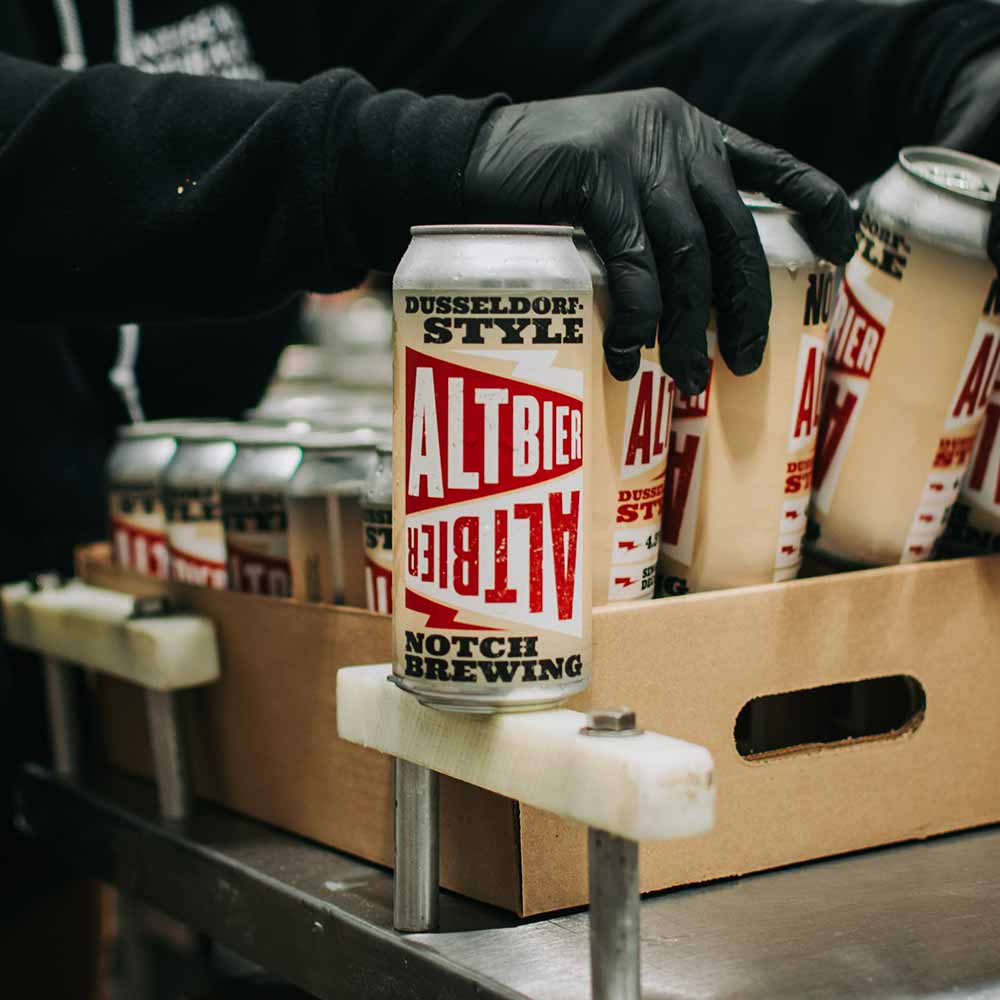
Photography courtesy of Rob Hughes | Notch Brewing
Decoction
Speaking of depth, decoction seems to be a pretty standard step for an Altbier. Notch does a single decoction with a thirty-minute boil. What Lohring calls a “mash-off decoction,” which just means you stop enzymatic activity in the mash mixer by pulling off a third of the mash at the end, bringing it right to boil for thirty minutes, and then returning it to get to a mash-off temperature of 170 degrees Fahrenheit.
“You’re getting all the melanoidins that contribute to the flavor profile of the beer,” says Lohring. We try to have a very dry Altbier. We don’t want it to be sweet; we want that bitterness to come through. It has to be backed up by a malt character as well, so not one note.”
Yeast, Fermentation, and Lagering

Photography courtesy of Hausbrauerei Zum Schlüssel
Here’s where things can get a little confusing again. Many Altbiers can ferment with ale yeast, but they ferment at cooler, lager-like temperatures.
“Lager is fermented cold; Altbier is fermented relatively cold for ale. It’s between ale and lager. [What] some call a hybrid,” says Lohring.
For practical reasons, Notch uses a kölsch beer strain in its Altbier to extend the life of the yeast, getting as many pitches as they can—eight generations if possible.
“The köslch yeast we use achieves the same goal, where we can have an ale yeast ferment cold and have an extended maturation time and clean the beer up,” says Lohring, who lagers Notch’s Altbier in horizontal tanks for about five weeks. “Because it’s an ale, you’d think it’d be quicker, but … it is our quickest lager.”
At Wayfinder, Rose Baldwin says they use a lager yeast—347—knocking out at 45 degrees Fahrenheit and setting the tank to 50 degrees Fahrenheit for fermentation, which she says is slightly different than some of their other lager beer. “There is a less intense ester profile from not using ale yeast, so it makes the aroma pop a little bit,” she explains.
Edmunds says at Breakside, they’ve played around with every combination of yeast and fermentation temperature. “We have used lager yeast cold to brew it like a traditional lager. We have used lager yeast warm. We have used ale yeast cold. We’ve used German ale yeasts that are purportedly kölsch and alt-type strains,” he says.
Eventually, he says they settled on a hybrid schedule, fermenting between fifty and fifty-four degrees Fahrenheit and raising the temperature to fifty-eight to sixty for the second half of fermentation. “I would describe it overall as a slightly warmer fermentation than our normal Bavarian lagers, but pretty low on the ester profile.”
As with some German lagers, Zum Schlüssel implements open fermentation, starting at 16 degrees Celsius and rising up to around 21 degrees Celsius, according to Rouenhoff, noting the brewery uses its own yeast strain that no other brewery is allowed to use. “That makes us very unique,” he says.
After two days of fermentation, Zum Schlüssel’s Altbier cold lagers for fourteen days. “It is important to have one warm day of post-fermentation to remove some fermentation by-products and bound CO2,” explains Rouenhoff. “We have no pasteurization or any other temperature treatment!”
So Is Altbier an Ale or a Lager?
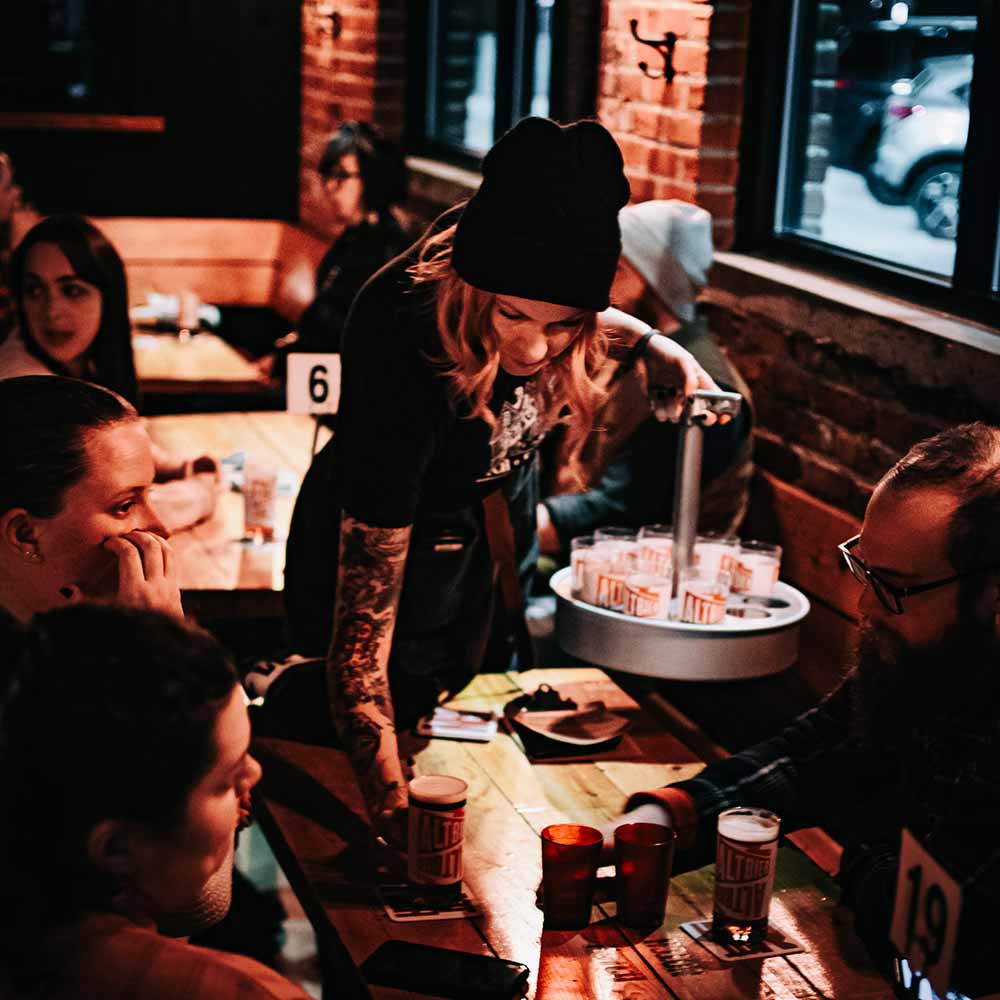
Photography courtesy of Rob Hughes | Notch Brewing
It’s another excellent question. And not to sound shady or noncommittal, but I think the answer depends.
Technically, these beers mostly leverage an ale yeast (but not always—looking at you, Wayfinder). And they ferment cold. So, who should say this style should be in one camp or the other?
“I always think of Alt as a lager, regardless of the yeast,” exclaims Edmunds. “To me, it drinks like that; it tastes like that.”
Altbier Service and Altbier Glass
Like Cologne’s kölsch service, Düsseldorf also provides its own Altbier service, refilling your glass with fresh Altbier until you place a coaster on top, signifying your waiter to stop.
Notch adheres as closely to tradition as possible for its version.
“For us, that’s all you can get that day,” says Lohring. “For those who come here, it’s a cool, fun experience.”
One main difference is the size of the glass. While both are served in a stange, Altbier stanges are shorter with thicker walls and top out at .25 litres, compared to a kölsch’s .2 litres.
“The kölsch glass is a little more delicate and taller,” explains Lohring. “Stange is German for rod, so it is a little bit taller, has thinner wall glass and smaller volume, and Alt is just a little shorter and wider, and the glass wall thickness is a little thicker. These are subtle differences, but they’re noticeable side by side.”
One other subtle quirk Lohring says he has noticed with Altbier service: the kölsch tray or kranz has a handle, whereas the Altbier kranz does not. “Which [for the waiter],” Lohring says, “takes more skill, I think!”
Well, What Do We Think of Altbier?
It’s definitely not the most popular style on the menu.
“Pretty low in terms of popularity,” chuckles Lohring, noting that Notch typically has fourteen beers on draft, and Altiber pretty much never cracks the top ten. “It’s not the bottom; it gets consumed enough that we have it on, but not year-round—only nine out of twelve months of the year.”
Wayfinder similarly only brews its Altbier around the December/January season, “but I think it can be super pleasant in summer when you’re looking for something with more character in a bunch of paler and hoppier beers,” says Rose Baldwin.
Likewise, Edmunds says Breakside won’t always have its Altbier on, but it’s in the rotation. “If we have one of these amber-type lagers on tap at all our pubs at once, then it always moves,” he shares. “But if we have two or three … they start to cannibalize each other.” He emphasizes that although Altbiers aren’t enormous sellers for Breakside, they’re a staple of what they do and don’t plan to stop anytime soon.
Still, the allure of this beer keeps people and brewers coming back.
Curious? Here Are A Few Versions of Albtier to Try
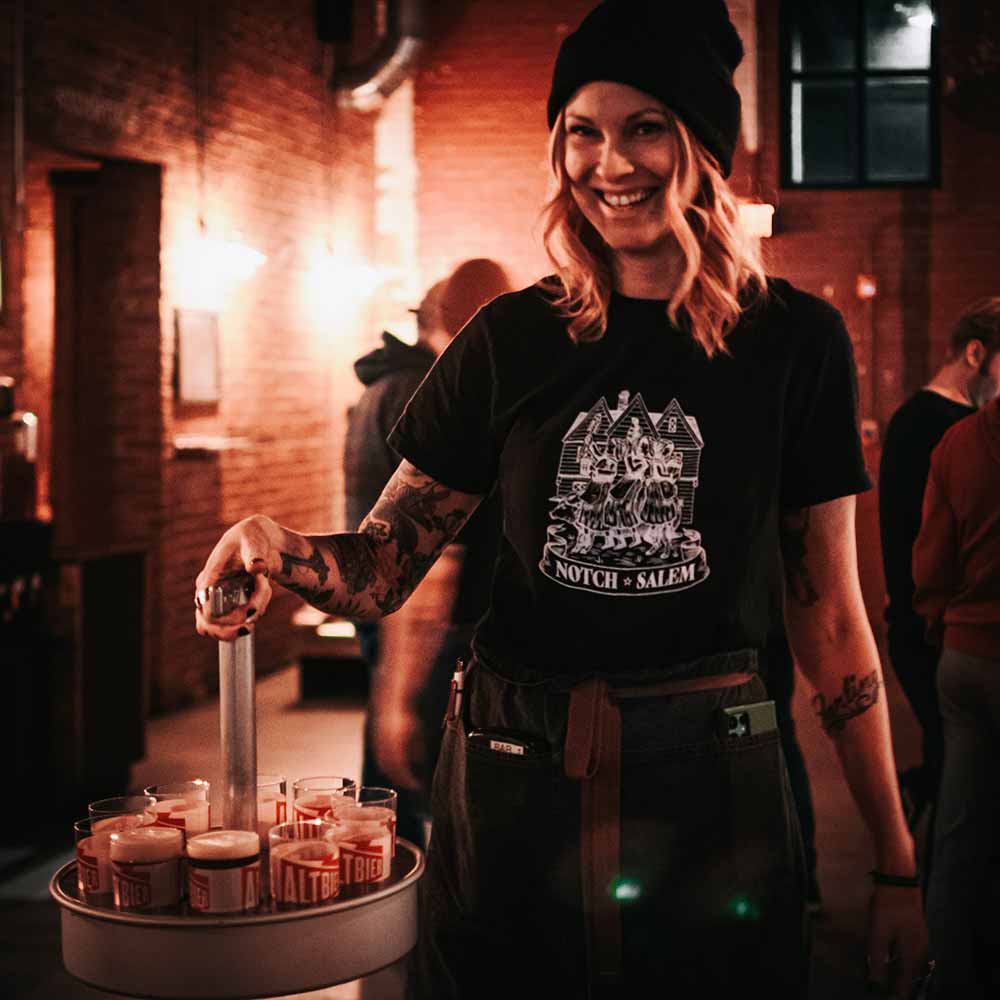
Photography courtesy of Rob Hughes | Notch Brewing
Altbier – Notch Brewing
Salem, MA
Notch’s copper-colored Altbier balances notes of sweet vanilla, earthy bitterness, and that nice crusty bread. Lohring single decocts to enhance that malt complexity before following an open fermentation (they tried a closed fermentation, too, and the former just seemed to work better) and long cold lagering, and natural carbonation.
Lohring calls Notch’s version “Düsseldorf-style,” explaining it has a bit more bitterness and less sweetness than you might find in other Alts.
“We haven’t changed the recipe from the very first time,” says Lohring. “We’re all about iteration and making things better, but with that one, we just got lucky, if I’m being honest!”
Original Schlüssel – Hausbrauerei Zum Schlüssel
Düsseldorf, Germany
The most-awarded Altbier in Germany, Zum Schlüssel’s Original Schlüssel Altbier pours amber to chestnut brown with a clear “stable, fine-pored, and light foam,” according to Rouenhoff.
On the nose, you’ll find “clear caramel notes and light-roasted aromas reminiscent of dark chocolate,” he says. While the sip will bring a full-bodied Altbier with a light, malty sweetness. “In the aftertaste, clear caramel notes and light-roasted aromas are noticeable,” he shares. “But the bitterness is not lingering. Such a harmonious finish creates anticipation for the next sip and encourages you to continue drinking.”
Sounds like the pretty perfect Altbier.
Alt School Like That – Novel Strand Brewing Company
Denver, CO
Originally a collaboration with Bierstadt Lagerhaus, Novel Strand’s Altbier hit all the right notes for Danon. So much so that he told Bierstadt Co-Founder and Brewmaster Ashleigh Carter, “Hey, I really like this beer; I think we’re going to keep making it.”
When asked to list a couple of his favorite Altbiers stateside, Pachmayer cites Novel Strands as one of his favorites. “It’s just dry and drinkable, doesn’t try to do too much, and executes what it does really well,” he shared with me.
Danon says that flavorwise, they’re going for about seventy percent towards a dunkel. “We want some of those more warming flavor notes, a more malty expression,” he says. “But to me, the delivery of that is still snappy … that allure of something sweeter happening without actually being sweet; it’s technically still a light beer to drink.”
Danon highly recommends drinking this beer in the fall when it just “hits that spot,” he says. “It’s really fun to drink Altbier when the leaves are that color, and the temperature cools at night, but it’s not cold yet—that’s Altbier.”
Alt – Uerige Obergaärige Hausbrauerei
Düsseldorf, Germany
Ask those who have been to Düsseldorf about their favorite version, and one name pops up repeatedly: Uerige Alt.
“The Uerige version is where my mind goes again, in part because of its snappiness, minerality, and lightness,” says Edmunds. It was such an eye-opening contrast to what I had experienced before.”
Lohring says Uerige’s Alt strikes a nice balance, with nothing sticking out too much. “From a brewer’s standpoint, that’s tough to achieve, and they did really, really well,” he shares. Also, it was the most drinkable.”
Uerige has brewed this legendary Altbier since 1862. According to its Untappd description, the brewery calls it a beer with “the highest content of bitter constituents. “Our Uerige Alt regularly ranks amongst the top ten beers of Germany.”
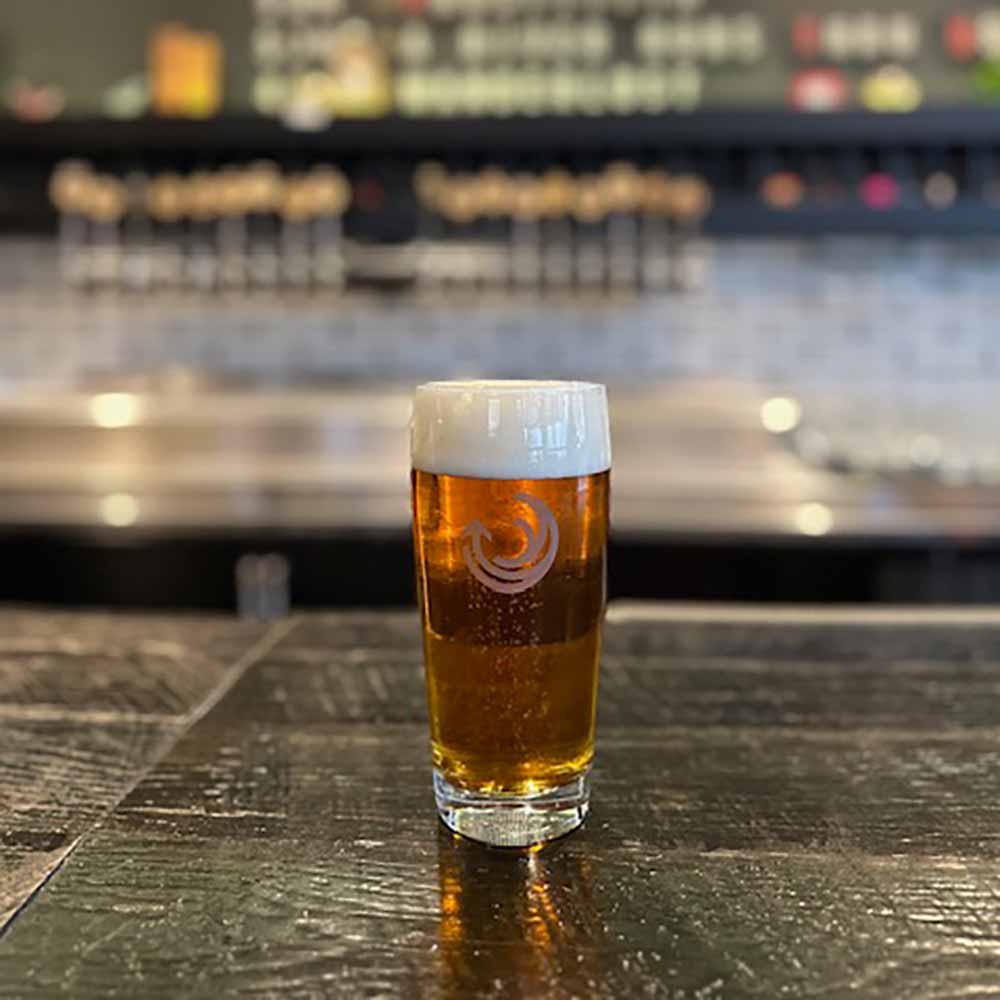
Photography courtesy of Breakside Brewery
Willy Buckets – Breakside Brewery
Portland, OR
Edmunds classifies Breakside’s Altbier Willy Buckets as more on the “dark-copper edge” for color.
“Aromatically, I think you’re going to get a little bit of spiciness from hops, but predominantly, you’re going to get some light caramel and toasty notes, maybe some kind of walnut-skin-type attributes, perhaps a whiff of sulfur, because I think that that’s an important part of fresh lager across the palate,” he says.
After an initial malt sweetness, the beer should dry out as you drink it. Just like a well-made German lager. “What’s adding to that dryness is the beer is actually quite bitter. The level of bitterness is going to be at Pilsner level or higher,” he says. “It’s not the softer, dark lagers that we make otherwise. So Pilsner-like bitterness … dryness in the finish, and it’s super refreshing.”
He says getting the beer to drink a lot drier than it actually is is “kind of the art of this beer.”
Fortuna Altbier – Wayfinder Beer
Portland, OR
Rose Baldwin describes Fortuna as amber-colored and clear with a little bit of those crusty-bread notes from the Munich malt.
“I don’t want to say raisin notes, but from the Caramunich, there is a deeper character, and the darker malt doesn’t really contribute an intense flavor but intense like the depth of flavor like bread crusty malt,” she says. “A little bit spicy, with a floral hop aroma and flavor, but not overly bitter but sort of present and noticeable.”
Altbier – Altstadt Brewery
Austin, TX
Another recommendation from Pachmayer, Altbier from the appropriately named Altstadt Brewery, “is a pretty solid one that I’ve enjoyed when visiting,” he shares.
This one pours pretty amber, drinking rich and malty thanks to caramel and darker malts. According to the beer’s Untappd description, “Using authentic Altbier yeast imported from Germany, Alt provides subtle toffee notes on the nose and finishes smooth.”

